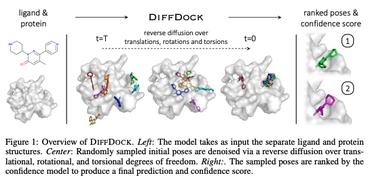Search Results for author: Hua Chai
Found 12 papers, 3 papers with code
LDTR: Transformer-based Lane Detection with Anchor-chain Representation
no code implementations • 21 Mar 2024 • Zhongyu Yang, Chen Shen, Wei Shao, Tengfei Xing, Runbo Hu, Pengfei Xu, Hua Chai, Ruini Xue
Despite recent advances in lane detection methods, scenarios with limited- or no-visual-clue of lanes due to factors such as lighting conditions and occlusion remain challenging and crucial for automated driving.
Pre-Training on Large-Scale Generated Docking Conformations with HelixDock to Unlock the Potential of Protein-ligand Structure Prediction Models
no code implementations • 21 Oct 2023 • Lihang Liu, Donglong He, Xianbin Ye, Jingbo Zhou, Shanzhuo Zhang, Xiaonan Zhang, Jun Li, Hua Chai, Fan Wang, Jingzhou He, Liang Zheng, Yonghui Li, Xiaomin Fang
In this work, we show that by pre-training a geometry-aware SE(3)-Equivariant neural network on a large-scale docking conformation generated by traditional physics-based docking tools and then fine-tuning with a limited set of experimentally validated receptor-ligand complexes, we can achieve outstanding performance.
GRASS: Unified Generation Model for Speech-to-Semantic Tasks
no code implementations • 6 Sep 2023 • Aobo Xia, Shuyu Lei, Yushu Yang, Xiang Guo, Hua Chai
This paper explores the instruction fine-tuning technique for speech-to-semantic tasks by introducing a unified end-to-end (E2E) framework that generates target text conditioned on a task-related prompt for audio data.
CANet: Curved Guide Line Network with Adaptive Decoder for Lane Detection
no code implementations • 23 Apr 2023 • Zhongyu Yang, Chen Shen, Wei Shao, Tengfei Xing, Runbo Hu, Pengfei Xu, Hua Chai, Ruini Xue
A lane instance is first responded by the heat-map on the U-shaped curved guide line at global semantic level, thus the corresponding features of each lane are aggregated at the response point.
 Ranked #1 on
Lane Detection
on CurveLanes
(Recall metric)
Ranked #1 on
Lane Detection
on CurveLanes
(Recall metric)
Graph Signal Sampling for Inductive One-Bit Matrix Completion: a Closed-form Solution
1 code implementation • 8 Feb 2023 • Chao Chen, Haoyu Geng, Gang Zeng, Zhaobing Han, Hua Chai, Xiaokang Yang, Junchi Yan
Inductive one-bit matrix completion is motivated by modern applications such as recommender systems, where new users would appear at test stage with the ratings consisting of only ones and no zeros.
S4OD: Semi-Supervised learning for Single-Stage Object Detection
no code implementations • 9 Apr 2022 • Yueming Zhang, Xingxu Yao, Chao Liu, Feng Chen, Xiaolin Song, Tengfei Xing, Runbo Hu, Hua Chai, Pengfei Xu, Guoshan Zhang
In this paper, we design a dynamic self-adaptive threshold (DSAT) strategy in classification branch, which can automatically select pseudo labels to achieve an optimal trade-off between quality and quantity.
Spatio-temporal Contrastive Domain Adaptation for Action Recognition
no code implementations • CVPR 2021 • Xiaolin Song, Sicheng Zhao, Jingyu Yang, Huanjing Yue, Pengfei Xu, Runbo Hu, Hua Chai
Unsupervised domain adaptation (UDA) for human action recognition is a practical and challenging problem.
An End-to-End Visual-Audio Attention Network for Emotion Recognition in User-Generated Videos
no code implementations • 12 Feb 2020 • Sicheng Zhao, Yunsheng Ma, Yang Gu, Jufeng Yang, Tengfei Xing, Pengfei Xu, Runbo Hu, Hua Chai, Kurt Keutzer
Emotion recognition in user-generated videos plays an important role in human-centered computing.
 Ranked #4 on
Video Emotion Recognition
on Ekman6
Ranked #4 on
Video Emotion Recognition
on Ekman6
Multi-source Distilling Domain Adaptation
1 code implementation • 22 Nov 2019 • Sicheng Zhao, Guangzhi Wang, Shanghang Zhang, Yang Gu, Yaxian Li, Zhichao Song, Pengfei Xu, Runbo Hu, Hua Chai, Kurt Keutzer
Deep neural networks suffer from performance decay when there is domain shift between the labeled source domain and unlabeled target domain, which motivates the research on domain adaptation (DA).
 Domain Adaptation
Domain Adaptation
 Multi-Source Unsupervised Domain Adaptation
Multi-Source Unsupervised Domain Adaptation
Multi-source Domain Adaptation for Semantic Segmentation
1 code implementation • NeurIPS 2019 • Sicheng Zhao, Bo Li, Xiangyu Yue, Yang Gu, Pengfei Xu, Runbo Hu, Hua Chai, Kurt Keutzer
In this paper, we propose to investigate multi-source domain adaptation for semantic segmentation.
 Ranked #2 on
Domain Adaptation
on GTA5+Synscapes to Cityscapes
Ranked #2 on
Domain Adaptation
on GTA5+Synscapes to Cityscapes
ROAM: Recurrently Optimizing Tracking Model
no code implementations • CVPR 2020 • Tianyu Yang, Pengfei Xu, Runbo Hu, Hua Chai, Antoni B. Chan
In this paper, we design a tracking model consisting of response generation and bounding box regression, where the first component produces a heat map to indicate the presence of the object at different positions and the second part regresses the relative bounding box shifts to anchors mounted on sliding-window locations.
POI Semantic Model with a Deep Convolutional Structure
no code implementations • 18 Mar 2019 • Ji Zhao, Meiyu Yu, Huan Chen, Boning Li, Lingyu Zhang, Qi Song, Li Ma, Hua Chai, Jieping Ye
An accurate similarity calculation is challenging since the mismatch between a query and a retrieval text may exist in the case of a mistyped query or an alias inquiry.








